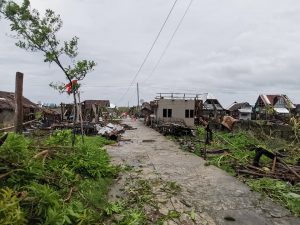Sixty seven died and fifteen persons are declared missing in a flash flood that inundated houses and caused landslides in the BARMM region as typhoon Paeng or “Nalgae” continue to ravage in the Philippines. Of those who died, 42 persons were from the five towns of Maguindanao.[1]
Initial reports of the Department of Social Welfare and Development (DSWD) as of October 28, 2022, there are initially documented 97,206 families or 409,455 persons from 733 barangays that are displaced in Regions V, VI, VII, IX, XII, and Caraga.[2] Of these figures, 12,304 families or 48,808 persons are currently taking temporary shelter in 506 evacuation centers. There are also 2,589 families or 12,214 persons temporarily staying with their relatives or friends in Regions VI, VII, and Caraga.[3]
Specifically in BARMM, there are 115,437 families or 572,185 persons that are affected from 36 barangays of Cotabato city and Maguindanao; 4,935 families in or 24,675 persons in North Cotabato; and 240 families or 1,117 persons in Caraga.[4] In Caraga region, affected areas are Butuan city, two towns in Dinagat island, and seven towns/city of Surigao del Norte.
As of the press time, there are 108 houses declared damaged by the typhoon. The majority of those damaged houses are in Region XII Pigkawayan, North Cotabato; Kalamansig, Sultan Kudarat; and Bato, Leyte.
Authorities of the National Disaster Risk Reduction Management Council (NDRRMC) expressed that the most affected areas of typhoon PaengPH are Region VI and BARMM regions. The affected populace is estimated around 7.9 million in Aklan, Antique, Capiz, Guimaras, Iloilo, Negros Occidental, and its urban cities. Also severely inundated are the areas of Maguindanao with an estimated population of 1.6 million, North Cotabato with 1.3 million populace, and Cotabato city with 325,000 populace. The affected provinces in Mindanao are geographically situated in the swampy river banks of the Cotabato River and the inland of Moro Gulf. Reports from residents posted on social media showed trees uprooted, rice fields underwater, livestock killed, and major vegetation like corn, coconuts, coffee, sugarcane, and bananas also severely impacted. Typhoon Paeng’s flooding is expected in the Pampanga River Basin and in its allied rivers by October 29 and October 30, cited by the NDRRMC. There are currently 175 areas that are heavily inundated and 21 reported landslides. Heavy to torrential rain is forecasted over Aurora, Metro Manila, Bulacan, Nueva Ecija, CALABARZON, Mindoro Provinces, Romblon, Marinduque, Camarines Norte, and Camarines Sur. Moderate to heavy with at times intense rains over Cagayan Valley, Cordillera Administrative Region, Western Visayas, and the rest of Central Luzon and Bicol Region. Light to moderate with at times heavy rains possible over Zamboanga Peninsula and the rest of Luzon and Visayas.
There are now 55 seaports declared non-operational; 696 cargoes and 65 vessels disallowed to sail; 2,845 stranded passengers.
NDRRMC further reported that 49 roads and five bridges are not passable in Regions 2, 5, and 6. About 8 municipalities suffered power interruption and Region VI confront problems with water supply interruption.
Classes are suspended in 347 affected cities and municipalities.
The flash floods and landslides are expected to bring large debris and floodwaters that can cause structural damage to bridges and roadways, including houses situated adjacent to mountain slopes, particularly in the eastern areas of Nueva Ecija Province inclusive of the towns of Gabaldon, Laur, Bongabon, Rizal, Gen. Tinio, Peñaranda, Carranglan, Palayan City and other adjacent towns, as well as in Bulacan Province, specifically the towns of Doña Remedios Trinidad, San Ildefonso, San Miguel, San Rafael, Norzagaray, Angat and other adjacent municipalities.
Flooding will likely cause impassable streets and submerge croplands in the provinces of Nueva Ecija, North, and Northeast towns of Bulacan, Pampanga, Southeast towns of Tarlac, and BARMM areas based on the forecast of NDRRMC.
Typhoon Paeng or “Nalgae” is moving in the north-western direction of the Philippines with strong gusts and gale-force winds with a maximum force equivalent to TCWS No. 4 or 75 km (47 miles) per hour. Air flights ans sea travels are canceled forcing thousands of people being stranded from traveling to observe All Saints Day and All Souls Days in their respective provinces.
[1] Provincial Diaster Risk reduction And Management Office of BARMM, Maguindanao.
[2] Department of Social Welfare and Development. https://dromic.dswd.gov.ph/wp-content/uploads/2022/10/DSWD-DROMIC-Report-6-on-the-Tropical-Storm-Paeng-as-of-28-October-2022-6PM.pdf
[3] DSWD DROMIC REPORT on Tropical Storm Paeng (https://reliefweb.int/report/philippines/dswd-dromic-report-5-tropical-storm-paeng-28-october-2022-6am
[4] DSWD


